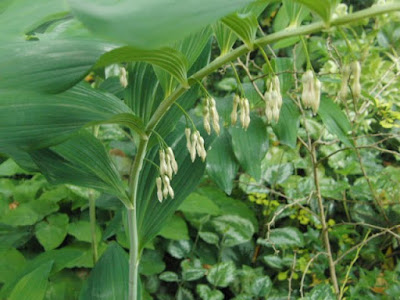Lots of us have areas of shade in our gardens, bits of space behind obstacles, fences, under trees and so on, and I have more than my fair share of shade, due to trees, as I've mentioned before. We have thinned out the trees to some extent over the years, but there is still a large area which will not accommodate plants requiring a "normal" amount of sun, and light. Additionally, areas under trees are often quite dry as the tree drinks up vast amounts of water, and its foliage acts as an umbrella to the ground below. This is a part of the scrubby bit of garden that I've chosen for my shade garden, where nothing much grows apart from weeds. So this is a "before" picture, the "after" picture will be a bit later...

Anyway, enough complaining, I have decided to make more of shade loving plants, and for the water requirements I will just have to bite the bullet, and make sure that I provide sufficient irrigation for them to survive. If anyone's looking for planting ideas for such an area, the plants I've used so far are
Hosta -Fire and Ice
Digitalis Lutea - the yellow foxglove
Sarcococca Confusa and Sarcococca Hookerianum, - Christmas Box, or Sweet Box in the US I think
Tellima grandiflora
Primula bulleyana - Candelabra primula
Primula denticulata - White Drumstick primula
Dicentra spectabilis Alba - the white form of bleeding heart
Polygonatum hybridum - no shady area would be complete without the wonderful elegant arches of solomans seal - one of my favourite plants, (I have it under some other trees)
All the above are plants known to do well in shady areas, but I have also planted a few things in slightly better conditions, in the hope that they will do ok. Concentrating mainly on white and lighter colours I have planted
Philadelphus, Belle Etiole - shrub with white scented flowers in summer
Physostegia Alba - vigorous herbaceous perennial, with spikes of white flowers
"Ground cover" rose - white, these are sold by most garden centres, and although not a choice plants for a rosarian, they are tough as old boots, grow in difficult positions, and are very trouble free and floriferous. Some of the colours are a bit garish, so white should be ok I'm thinking.
Viburnum plicatum "Maresii" a wonderful shrub with tiers of white blossom in early summer.
I already have the native viburnum opulus, or guelder rose, which is doing reasonably well, in the mid-shade area.
Some of these are experiments, so I will have to keep a regular eye on them and watch the watering needs, especially over the first summer. Updates follow in due course.
 So I kind of forgot about Borisii and it got a bit overgrown with creeping buttercups, to which it bears a superficial resemblance, so I was surprised to find it coming into flower a few weeks ago, around the time the lockdown started. It was doing ok actually, but then there were a few sharp frosts and all those overwhelming weed issues, and it started to look a bit sick.
So I kind of forgot about Borisii and it got a bit overgrown with creeping buttercups, to which it bears a superficial resemblance, so I was surprised to find it coming into flower a few weeks ago, around the time the lockdown started. It was doing ok actually, but then there were a few sharp frosts and all those overwhelming weed issues, and it started to look a bit sick. 



































